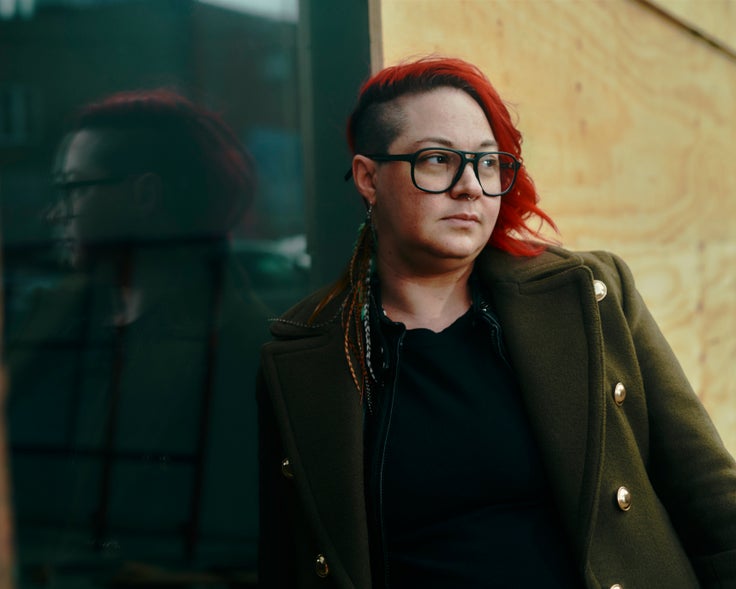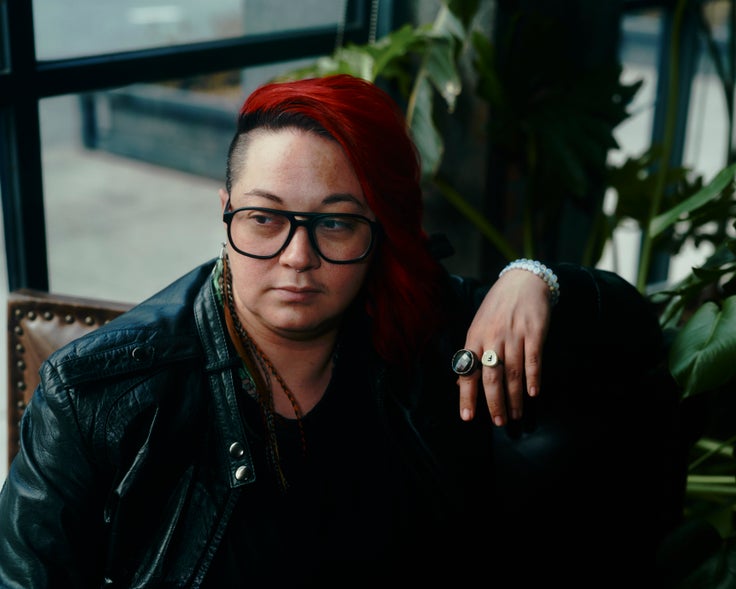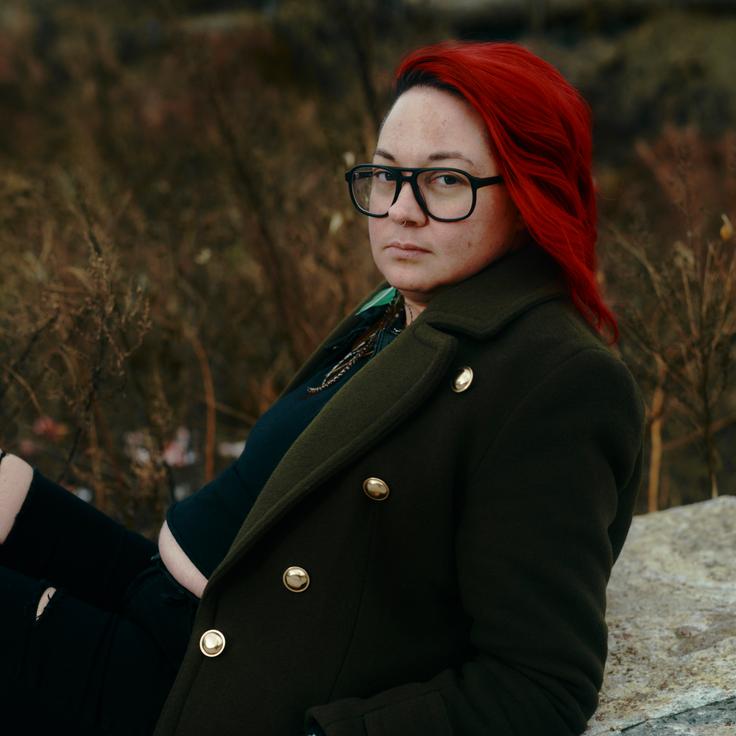I used to be pretty.
Pretty in a conventional way, meaning that I could access a kind of thin, Eurocentric femininity that made me legible as attractive in the ways the beauty magazines defined it. My hair grew long and straight, my tits were perfectly perky and round, and could be accentuated with a pushup bra to hover just below my chin. My facial features were delicate, and I could carefully remove my thick, black hair from the places on my body that society told me it shouldn’t be: my legs, my armpits, my bikini line — or my entire mons, depending on which era we are talking about.
Being pretty took work, which I learned at a young age.
Age 10, shaving the still baby-fine hair from my still baby legs. Age 11, my mother taking me to the salon to have my “unibrow” and “mustache” waxed. It was a rite of passage for me ― a young, American Ashkenazi girl being taught to assimilate to white American beauty standards, erasing whatever vestiges of Semitic looks I might possess. This kind of assimilation began for many Ashkenazi Jews after the Holocaust, when they moved to new lands to escape persecution and there was safety in the ability to disappear into whiteness. My own family had to come to the United States at the turn of the 20th century to escape the pogroms in what is now Ukraine.
Being pretty was the most important thing a girl in my family could be. We were never complimented on anything else — the first thing my grandmother would say when she saw me was how pretty I looked. As I got older and cut off my hair, I would be told how much prettier I had looked with long hair. When I began wearing glasses, my mother always asked why I didn’t get contacts because the glasses “covered up my pretty face.”
The first thing I did after separating from my husband was stop shaving my armpits.
In my marriage to a cishet man, I slowly became more and more visibly queer, meaning that I chose to reject cishet beauty norms. All queers do that to some extent, even femmes who mostly conform to traditional standards of beauty are rejecting norms by rejecting desire for the male gaze. But even as my appearance became less conventionally attractive, my shaven armpits were the last piece of traditional femininity that I held on to.

Once I left my husband, I made a conscious decision to let it grow. I watched as it moved past the stubble I’d dutifully shaved off every other day since I was 13 years old. I marveled as it softened, and noticed the subtle change in my scent that came along with it.
But even after deciding to grow it out, I never thought I would love it. I loved it on other queer bodies. But I didn’t think it would look cute on me. My hair is so dark. It’s so thick. There’s just so much of it.
The history behind the normalization of hairless women has been pretty well documented: Here in the U.S., it was a beauty norm largely created by razor companies and others in the beauty industry in order to sell their products.
Ironically, as more progressive values swept in and women gained autonomy and freedom of movement — sleeves and hemlines got shorter; women were free to navigate more areas of public space — more restrictive beauty norms around body hair were creeping in, limiting expression in other ways. The importance of hairless bodies was reinforced throughout the growing number of magazines marketed towards women.
Hair removal advertisements in the early 20th century were often targeted at Jewish, Italian and Eastern European immigrant communities in the U.S. as a way to remove racial markers and help them assimilate into whiteness. “Hairy women,” Rebecca M. Herzig writes in her book “Plucked: A History of Hair Removal,” became synonymous with “failed women.”
Women who do not conform to this standard have often been punished or stereotyped. There is the “hairy feminist” trope, of course. But there was another kind of woman that body hair has always been associated with: lesbians. Women who rejected the idea of conforming to traditional standards of femininity were often called “masculine” and assumed to be gay. This stereotyping and homophobia has directly contributed to violence and marginalization of people whose bodies are visibly queer.
All of this being said, what I did not expect was how hot it would make me feel to have hair under my arms. Part of the appeal of my pit hair is that it makes me attractive to the people I want to be attractive to: not the cishet men I was taught by books, magazines and television shows that I was supposed to want to attract, but to other queers.
A 2017 study found that one in four women under the age of 25 have stopped shaving their underarms. The second half of 2019 was full of trend pieces about hirsute women coming back into vogue. But it’s often queer women who forgo the traditional beauty standards first, rejecting the male gaze and the cishet beauty ideals forced on them. Queers have been reclaiming our bodies for a long time, and have suffered consequences for that reclamation, with queers of color being punished most harshly.
Three years after growing out my pit hair, I found myself sitting in a doctor’s office. “What are your transition goals?” my doctor asked me, while deciding whether I qualify to be prescribed testosterone.
To confuse cis people, I think. But I know I can’t tell her that, lest the cis gatekeepers deem that I don’t meet the standards for taking the hormone. What I want is for cis people to pause — even momentarily — before gendering me. And to be unsure which pronoun to use for me, even if they ultimately decide I’m a “she.”
Instead, I tell her the things I know doctors want to hear: My voice is too high, I’d like it to drop. I want bottom growth. I want to look more ambiguous in gender.
“And body hair?” she asks. I nod, avoiding the question to the best of my ability.
I spent a year deciding whether or not I wanted to go on testosterone before actually starting. When I thought about the changes that could happen to my body, I was ambivalent about most of them. But there was one change that terrified me: body hair. The idea of growing a beard or mustache did not appeal to me at all. I imagined myself as a woman with a beard and immediately had flashbacks to my mother taking me to have my face waxed as a child. I thought about chest hair sprouting on and between my tits, and I completely shut down.
Body hair, I was convinced, would deny me access to the prettiness I was told I needed to possess to be worthy. Even in the trans community, the kinds of bodies that are upheld as ideal conform to white, cis beauty standards in many ways. Everywhere I looked, body hair, femininity and desirability seemed incompatible.

The fear of losing access to cis standards of beauty surprised me. I’d spent years intentionally distancing myself from them, growing out my leg hair and then my armpit hair, wearing clothing that did not pander to the male gaze. I fought so hard against these standards of beauty that had been nonconsensually put on me, beauty ideals that felt like a prison.
But knowing that I could never go back to that kind of beauty felt terrifying. I had largely given it up, but that was a choice I made that I knew was reversible. By going on T and making my gender ambiguous and confusing and decidedly against the cis gaze, I would forever be letting that access to power — and therefore privilege — go. I would retain my white privilege and thin privilege, of course, but in my new body my safety would be conditional, something I could lose the instant someone understood me to be trans.
The narrative of the irreversibility of hormone replacement therapy is concern-trolling rhetoric fed to me by cis people, designed to prevent people from transitioning, designed to scare people out of being trans, hidden behind the guise of concern for our well-being. The truth is that bodies change all the time — with age, with pregnancy, with plastic surgery.
Very soon after the testosterone entered my system, my Ashkenazi genes took over. The hair above my lip darkened quickly. The hair on my belly did, too. New hairs started sprouting from my breasts. I knew that transition was not a buffet where you could pick and choose the parts you wanted, but I also thought the new body hair would take a while before it sprouted, giving me time to adjust to the idea that it would appear. My rationality informed me that my resistance to it was likely my own internalized cissexism, but emotionally, I struggled to accept the changes, quietly wondering if I’d made a huge mistake and ruined my body by starting testosterone.
Yet, I am still pretty.
I know this because my partners tell me so. “You’re such a pretty boy,” they say. “What a pretty fucking faggot,” they coo at me before kissing my face and stroking the dark hairs that are populating my upper lip, a sad excuse for a mustache that looks like it could be found on a boy stepping up to the bimah to read his Haftarah portion at his Bar Mitzvah, but a sign of things to come.
I can’t wait for you to have chest hair and tits. You’re going to be such a pretty boy.
I imagine myself with a mustache, putting on eyeliner and nail polish — neither of which I currently own. I picture myself with chest hair and breasts, zipping up a leather dress — something I haven’t worn in years. I imagine myself with the word “MILF” tattooed in Old English across my fuzzy belly, claiming my place as a mustachioed hot mom.
As it turns out, the idea of being a pretty boy brings warmth to my chest that my attempts at being a pretty girl never did.
